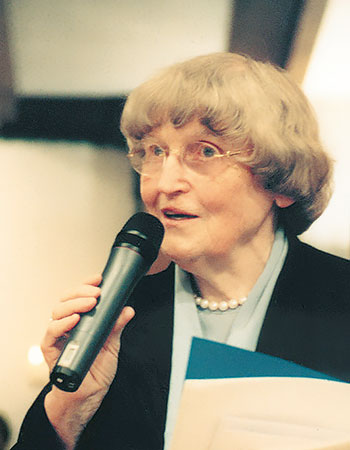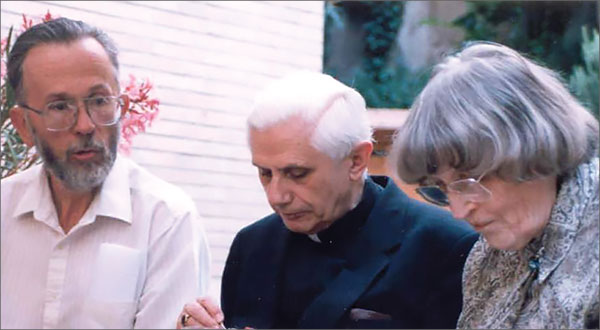Subtotal: $
Checkout-

The Man Who Welcomed Immigrants
-

The Soil of Friendship
-

Thomas Müntzer
-

A Time for Courage
-

“What is Truth?”
-

Readers Respond Issue 12
-

At the March For Life
-

Why the Death Penalty Must Die
-

God’s Cop
-

The Teacher Who Never Spoke
-

Bonhoeffer in China
-

The Comandante and the King
-

Confronted by Dorothy
-

Insights on Courage
-

The Art of Courage
-

Why We Hope
-

Harlem Postcards
-

T. S. Eliot’s “Little Gidding”
-

The Need of Refugees
-

Listening to Silence
-

Editors’ Picks Issue 12

Next Article:
Explore Other Articles:
Already a subscriber? Sign in
Try 3 months of unlimited access. Start your FREE TRIAL today. Cancel anytime.
Gertraud “Traudl” Wallbrecher was nine years old when Hitler rose to power in her native Germany, and sixteen when World War II began. As the leader of a Catholic Youth Movement group of girls, she experienced firsthand the terrors of dictatorship, risking her life in the underground resistance. At the same time, she saw how many churchgoing Christians succumbed to Hitler’s ideology out of fear, opportunism, or conviction.
Drafted into military service in a hospital near Munich in 1945, she was brought face to face with the horrifying extent of Nazi brutality when she witnessed the evacuation of the Dachau concentration camp. For the rest of her life, the horror she had seen kept her asking: “How could this crime – especially the mass murder of my Jewish fellow citizens – have happened in a country that is so thoroughly Christian? Why wasn’t the church strong enough to mount an effective resistance?”
After the war, Wallbrecher hoped that the restoration of civil liberties, including religious freedom, would be accompanied by a wave of deep-going repentance and revival. Yet that is not what happened. Instead, she watched as an unprecedented, silent exodus from the church began – a process of de-Christianization whose contours are only now becoming clear.
Already a subscriber? Sign in
Try 3 months of unlimited access. Start your FREE TRIAL today. Cancel anytime.
Wallbrecher sought to respond in a way that was not just theoretical but practical. At that time she met a young man, Herbert Wallbrecher, who shared her background in the Catholic Youth Movement and also her questions. What should church life look like in the aftermath of the war and the Holocaust, which had called every value into question? The two were drawn together in their seeking and married in 1949.
From the very start, the young family became a magnet for like-minded believers searching for a new expression of church life. In theologian Hans Urs von Balthasar’s afterword to Paul Claudel’s play The Satin Slipper, the group found a question they felt to be the key challenge: “How is it possible to live completely in the world, yet in full obedience to God?” Through their study of liturgy and with new methods of biblical interpretation, the group realized that the original life of the church had been, quite simply, community. For example, it was to church communities sharing a common life (koinonia) that the apostle Paul addressed his letters. In fact, these were the communal churches in which the texts that we now know as the New Testament first took shape.
Would it be possible to pick up the thread of New Testament–style community after so many intervening centuries? No, on the one hand: today’s spiritual, cultural, and social conditions are far too distant from those of the biblical world. Yes, on the other hand: because the church is still, at its heart, a community – one that is open to all believers, not just clergy and monastics.
On the basis of this conviction, an ambitious and unpredictable experiment began. People of diverse backgrounds, ages, and professions joined together in a common life; in many cases they literally lived together, worked together, and pooled their income. Their communal life also found its expression in liturgical celebrations. The apostle Paul’s picture of the body of Christ as being one body with many different members inspired the new community’s name. Borrowing a word popular in the 1960s, they named themselves the Integrierte Gemeinde (Integrated Community). In 1978, the new movement was officially recognized by its local bishops, one of whom was Joseph Cardinal Ratzinger.
For Wallbrecher, a special passion was building bridges to faith for people who had lost their connection to the church. In her view, this would require a convincing and fresh manifestation of church life that was not bound to received traditions. She found inspiration in the works of modern authors and filmmakers as well as in other communities, such as the kibbutzim in Israel, which she visited repeatedly. In all this, her goal was a way of life as appealing as the city on the hill and the light of the world. Holding fast to the biblical promise that God always wants to “make all things new,” her efforts anticipated what the Catholic Church would later refer to as “the new evangelization.”
Pope Benedict XVI, who has been the community’s friend and mentor over the decades, summed up the essence of Wallbrecher’s life when he wrote to her in 2008:
The flame that you ignited in 1948 has not been extinguished. The fire of the Holy Spirit burns away much that is human, yet ignites a light that spreads its warmth even beyond the bounds of time, since it comes from God’s spirit. May the quiet flame of your community always feed on the greater communal flame of the Church’s faith and thus become one of the fiery tongues by which the Holy Spirit speaks in this world.
Traudl Wallbrecher died in July last year; her husband Herbert had preceded her in 1997. She leaves behind a church community that still strives to live “completely in the world, yet in full obedience to God.”
This article is a translation by Erna Albertz of “Gott schafft immer Neues,” in Theologica No. 3 (Katholische Integrierte Gemeinde, 2016).
 Traudl Wallbrecher Photograph courtesy of Katholische Integrierte Gemeinde.
Traudl Wallbrecher Photograph courtesy of Katholische Integrierte Gemeinde.What is Church Community?
Traudl Wallbrecher
The church community (Gemeinde) knows that it is utterly dependent on God’s daily mercy. It recognizes that each of its members falls far short of perfection, and that the community as a whole is altogether unworthy of and unsuited for its task. The community is constantly struggling for faith, for unanimity, for faithfulness, and for wakefulness. Threatened from within and from without, it survives only thanks to God’s care. I know, of course, that the universal Church’s heroes and saints are stationed elsewhere – and yet the community has a duty to speak of how God is at work within its own small fellowship.
The church community … must show the surrounding world that even today all areas of life can find their liberation within the kingdom of God. Through its unanimity, it can demonstrate that human beings are able to live together in peace.
From a letter to Joseph Cardinal Ratzinger, 1983
Already a subscriber? Sign in
Try 3 months of unlimited access. Start your FREE TRIAL today. Cancel anytime.
The Integrierte Gemeinde and the Bruderhof

Traudl Wallbrecher with then-Cardinal Ratzinger and Johann Christoph Arnold, senior pastor of the Bruderhof communities, at a 1995 meeting in Rome. Photograph by Marcus Mommsen
The Integrierte Gemeinde and the Bruderhof are sister communities, one Catholic and the other Anabaptist, that are both inspired by the early church. At this historic meeting convened by Wallbrecher, Cardinal Ratzinger and Pastor Arnold together read aloud accounts of the martyrdom of sixteenth-century Anabaptists at the hands of Catholic rulers. Ratzinger then remarked:
What is truly moving in these stories is the depth of faith [of these men], their being deeply anchored in our Lord Jesus Christ, and their joy in this fact, a joy that is stronger than death. We are distressed, of course, by the fact that the church was so closely linked with the powers of the world that she was able to deliver other Christians to be executed because of their beliefs. This should be a deep challenge to us, how much we all need to repent again and again, and how much the church must renounce worldly principles and standards in order to accept the truth as the only standard, to look to Christ, not to torture others but to go the way of witnessing ourselves, a way that the world will always oppose, a way that will always lead to some form of martyrdom.…
It is important [to realize] that we cannot bring about unity in the church by diplomatic maneuvers. The result would only be a diplomatic structure based on human principles. Instead, we must open ourselves more and more to [Christ]. The unity he brings about is the only true unity. Anything else is a political construction, which is as transitory as all political constructions are. This is the more difficult way, for in political maneuvers people themselves are active and believe they can achieve something. We must wait on the Lord, that he will give us unity – and of course we must go to meet him by cleansing our hearts.

Did you know that Plough is published by the Bruderhof, a living community of people seeking to follow Jesus together?
Dr. Bernhard Koch is a member of the Integrierte Gemeinde and its Community of Priests.
Already a subscriber? Sign in
Try 3 months of unlimited access. Start your FREE TRIAL today. Cancel anytime.































Erna Albertz, Plough.com
Wallbrecher wrote, "The church community must show the surrounding world that even today all areas of life can find their liberation within the kingdom of God. ...It can demonstrate that human beings are able to live together in peace." Do you agree? Have you experienced this to be true?